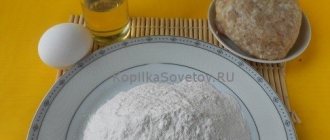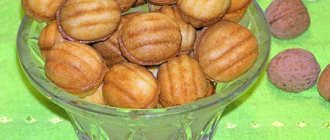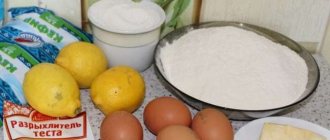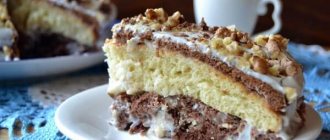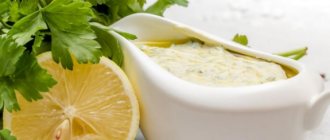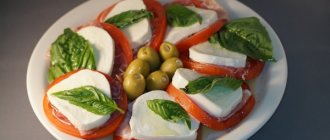Posted on by Home Baked
3,725
In fact, panettone is a traditional Italian Christmas pastry that originated in Milan and is widespread throughout the world. The shape and texture of this pastry resemble Easter cake, which is why in our country panettone is most often baked for Easter. However, unlike Easter cake, panettone is more airy.
We offer you a very detailed recipe from food blogger Alla Ershova.
This is the original recipe for Milanese panettone (known online as Adriano Continisio's Panettone). The recipe is not simple; it will take you 3 days to prepare this panettone.
- Ingredients and Process
- Almond coating
- Additionally
- Day 1 Morning 7:00 First dough “Biga”
- Additionally:
- The second dough is “polish” (fragrant)
- Morning 9:00 First batch dough
- Second batch dough
- Third dough
- Third batch dough
- Fourth batch dough
- Morning 9:00
Panettone Giorilli recipe
To prepare real panettone according to Giorilli's sourdough recipe, you will need the following ingredients.
First dough (dough):
- wheat sourdough 50% humidity Levito Madre – 70 g;
- water – 120 g;
- premium wheat flour – 240 g;
- sugar – 75 g;
- butter 82% fat – 70 g;
- yolks – 55 g.
Emulsion:
- honey – 15 g;
- zest of ½ lemon;
- zest of ½ orange.
Second dough:
- all first dough (dough);
- premium wheat flour – 60 g;
- white malt – 2 g;
- sugar – 65 g;
- vanilla sugar – 10 g;
- yolks – 95 g;
- salt – 4 g;
- whole emulsion;
- butter 82% fat (soft) – 120 g;
- butter 82% fat (melted) – 10 g;
- raisins – 120 g;
- candied orange peels – 60 g;
- candied lemon peel – 30 g.
(if the starter is weak, then add 0.5 g of dry yeast to the dough).
This amount of ingredients yields about 1200 g of finished dough.
Italian Easter panettone
Easter panettone contains dried fruits, nuts, and candied fruits and is a traditional treat in Italy on Christian holidays. Many housewives use the recipe for Christmas and Easter, since the Italian dish is very similar to the standard Easter cake, although it has its own differences. Panettone does not add a lot of eggs and butter, but is generously flavored with spices: cardamom, nutmeg, vanilla.
- 200 g sugar;
- 150 g butter;
- 100 ml milk;
- 400 g flour;
- 40 g fresh yeast;
- 50 g almonds;
- 6 eggs;
- 100 g raisins;
- Lemon;
- 70 g candied fruits;
- 2 small spoons of lime juice;
- A teaspoon of vanilla sugar;
- Salt - a pinch;
- 60 ml cognac;
- About 1/2 small spoon of cardamom;
- A teaspoon of ground nutmeg.
- Pour boiling water over raisins and pour cognac;
- Melt the butter;
- Dissolve the yeast with a small amount of granulated sugar in warm milk and leave for 15 minutes;
- In a container, mix flour, vanilla, butter, yeast, 100 g of sugar, spices;
- Add 4 eggs and 2 yolks to this mass;
- Next, add candied fruits, lemon zest, raisins, slightly dried and chopped almonds (dried apricots are fine). Mix the dough mixture and place it in a warm place to rise for about an hour;
- Coat the Easter cake molds with butter, add one third of the dough and let it sit for a while;
- Bake for an hour at 180 degrees, then cool;
- Beat 2 egg whites with a pinch of salt, gradually add lime juice and 100 g of sugar. Pour the finished glaze onto the Italian cakes, dry them a little in a warm oven, and decorate as desired.
Usually Italians do not cover the “Milanese dish” with glaze; this is a matter of taste. You can simply sprinkle with powdered sugar.
Preparation for baking panettone
The preparation of real panettone with sourdough can be divided into 3 stages.
The first is preparing the starter. For baking panettone, only wheat sourdough with 50% humidity is used, which is also called Levito Madre. It must be active and strong enough to cope with the dough. But in any case, Levito Madre needs to be prepared for baking panettone. For example, if you decide to bake panettone on Saturday, then you need to start preparing the sourdough on Thursday evening, so that by Friday evening you already have a strong Levito Madre.
Each baker has his own proven method for preparing sourdough starter. There are already several detailed articles about this on my website. For example, here is one of the methods: “Levito Madre sourdough for panettone, pandoro dough: how to prepare.”
Preparing the first dough
In Italy, the dough for real panettone is usually called the first dough. I start preparing it at 20:00 in the evening. By this time, I had prepared all the necessary ingredients in advance. In 2 hours I took the butter and eggs out of the refrigerator. During this time the butter will become soft and the eggs will warm to room temperature.
I will knead the dough by hand, but if you have a planetary mixer or dough kneader, then of course, use their help.
Now you can start cooking. For the dough, take a transparent bowl so that you can easily observe its growth later.
In a bowl I add 70 g of Levito Madre 50% moisture wheat starter. By this point the starter should be at the peak of its activity. It smells very nice and does not taste sour at all.
Flour for panettone
I add 120 g of water at room temperature to the starter and mix everything until smooth. Then I add wheat flour to the bowl. When baking panettone, try to choose flour with a high protein content, starting from 13%. But if you haven’t found such flour, then premium wheat flour with a protein content of 10.3% and panettone will also work. Now I just use premium wheat flour, which contains 10.3% protein.
After adding the flour, you should get a fairly dense dough. I transfer it to the table and continue kneading until the dough becomes homogeneous, smooth and elastic. For this I needed 5 minutes of kneading.
Adding Other Ingredients
Then I add 75g of sugar. Just add it not all at once, but gradually, kneading well after each addition. When all the sugar has been added to the dough, continue kneading until the sugar can no longer be felt under your fingers. After adding sugar, the dough becomes softer.
Now I add 55g egg yolks. Mix in the yolks gradually too. The dough is now more sticky. Therefore, it is most convenient to knead it with your hands using the beating technique. Knead the dough until it becomes homogeneous and smooth again.
It remains to add 70 g of softened butter. Add the oil gradually, kneading the dough well before adding it each time.
The finished dough should have well-developed gluten. This can be checked using a gluten window test. If the dough stretches into a thin elastic film, it means the gluten is well developed and you can stop kneading.
Then I transfer the dough into a transparent bowl and cover it with film on top. Leave the bowl with this dough at room temperature +24°C for 12 hours. During this time, your dough should increase at least 3 times.
Panettone - Italian Easter cake
Italians, like us, prepare their own Easter cake for one of the most important holidays. It is called “panettone”, which translates as “bread of luxury”. And it’s true: it contains a huge amount of ingredients and a lot of dried fruits. Less often, cream is added: chocolate, vanilla, cream, etc.
Panettone, due to the addition of alcohol and a long “rest”, is much softer than our Easter cake, and is stored longer. Its delicate texture, sweetness and high content of raisins or candied fruits make it a favorite not only of children, but also of adults. In Italy it is baked more often for Christmas than for Easter.
Today, many housewives are trying to bake this foreign cake. Milan is considered its homeland and was baked during the Roman Empire. There is no original recipe; they usually add whatever they want to the cake: nuts, various fruits and dried fruits, chocolate, seeds.
Slavic women love to cook much more, and therefore today we offer you to familiarize yourself with two different recipes for preparing this yummy. Depending on your desire, you can prepare a quick or traditional version. In any case, it will be unforgettably delicious!
Read our article on how to prepare an incredibly tasty and tender Easter cake made with yolks.
Read how to cook great jellied meat in a slow cooker.
So that no one says about your fish: “What disgusting”, learn to cook it correctly. Our step-by-step recipes with photos will help you prepare a masterpiece.
| Ingredients | Quantity |
| rum (preferably light) - | 20 ml |
| water - | 170 ml |
| flour - | 545 g |
| raisins - | 175 g |
| yeast - | 5 g |
| eggs - | 3 pcs. |
| candied citrus fruits - | 145 g |
| butter (soft) - | 260 g |
| salt - | 4 g |
| lemon zest - | 7 g |
| granulated sugar - | 160 g |
| vanilla - | 5 g |
| honey - | 40 ml |
| cold butter - | 15 g |
| melted butter - | 15 ml |
| Cooking time: 1320 minutes | Calorie content per 100 grams: 349 Kcal |
You need to prepare Italian panettone cake at home like this:
- In one container, mix raisins, two tablespoons of water and rum. Stir until the dried fruits have absorbed almost everything;
- In another bowl, combine flour, lemon zest, yeast, half a vanilla pod, salt and sugar;
- In a small bowl, beat eggs with water (be sure to be warm) and honey. Eggs should be at room temperature;
- Pour the egg part into the flour mixture and stir until smooth;
- Add softened butter a spoonful at a time and stir in. The finished dough should be quite soft; kneading will take about eight minutes;
- Remove excess moisture from the container with raisins, pour candied fruits into it and pour in the indicated amount of melted butter, stir;
- Using a wooden spatula, stir the dried fruits into the dough;
- Transfer the dough to a large bowl and place in a warm place, preferably wrapping everything in cling film. Let rise three times for 13-15 hours;
- Take out the vanilla, roll the dough into a ball and place it in a mold generously sprinkled with flour or, alternatively, coated with butter;
- Cover with a slightly damp cloth and keep for another five hours; let rise in a warm, draft-free place. The dough should rise above the pan;
- Preheat the oven to 190 Celsius;
- Make a cross-shaped cut at the top of the mold and place a piece of cold butter in the very center. Bake until a toothpick or skewer is no longer wet when inserted into the dough. But they must remain moist;
- Let cool and decorate to taste.
Preparing raisins and candied fruits
I also prepare raisins and candied fruits in the evening. You will need to pour boiling water over 120 g of raisins and leave for 15 minutes. Then drain the water and place the raisins on a plate until the morning to dry.
Then I weigh 90 g of candied fruits into one bowl. Here I have candied orange, lemon and I decided to add candied pamelo.
I also pour boiling water over the candied fruits and leave for 15 minutes. I prepared all these candied fruits myself, and this recipe is on my website: “Candied orange peels at home, how to cook, make.”
After 15 minutes, drain the water from the candied fruits and place them on a plate to dry until the morning. Since my candied fruits are large, I decided to chop them into smaller pieces.
Preparation of the emulsion
And the last evening preparation for real panettone is the emulsion. It is prepared very simply: just mix all the necessary ingredients: 15 g of honey, half a lemon zest and half an orange zest. Mix everything until smooth.
Then cover the emulsion with film and leave at room temperature until the morning.
Kneading the second dough
The next day in the morning I check the readiness of the dough. By 8 o'clock in the morning my dough had more than tripled in size in the bowl.
If 12 hours have already passed and your dough is slowly maturing, then put it in the oven under the light on for 1-2 hours. It is very important that the dough increases at least three times its original volume. And only then can you continue to knead it further.
Since my dough has grown more than 3 times in volume, I can continue to work with it. To do this, I transfer it to the table. For ease of kneading, immediately prepare all the necessary ingredients and place them in front of you.
Now I will add wheat flour and white malt to the dough and mix everything until smooth. If you don’t have white malt, then you simply skip this ingredient.
Do you need dry yeast for panettone?
At this stage you can add 0.5 g of dry instant yeast. Add yeast only if your Levito Madre starter is not strong enough. And then it’s better to play it safe and add yeast. I didn’t add any yeast because I know that my Levito Madre starter can handle the dough.
Adding flour and sugar to the dough
As for the dough and for this dough, flour must be used with a high protein content, at least 13%. But today I’m showing you how to knead panettone using premium wheat flour, which contains 10.3% protein.
After adding flour the dough became dense. But it needs to be kneaded well so that it becomes smooth and uniform.
Then I add 65 g of regular sugar and 10 g of vanilla sugar to the dough, which I prepared in advance and mixed together. Add sugar to the dough in portions, kneading well before each addition.
Now you need to add half the yolks. We'll add the second half later. Once the dough becomes homogeneous, add 4 g of salt to it. Knead until grains of salt can no longer be felt under your fingers. After this, add the emulsion that you prepared last night to the dough.
Now add the second half of the yolks and continue kneading to a smooth, elastic dough.
Butter into the dough
As soon as the dough becomes elastic, start adding 120 g of softened butter in portions.
Then add 10 g of melted butter at room temperature.
Continue kneading the dough until the gluten is well developed. You can check this using the gluten window test, stretching the dough into a thin transparent film.
And once the dough is well mixed, only then can you add raisins and candied fruits.
After this, transfer the dough into a bowl, cover the top with film and leave to ferment for 30 minutes at a temperature of +28-30°C. To do this, I put the dough in the oven and turn on the light bulb.
Panettone - Italian style Easter cake
Panettone (from Italian panettone) is an Italian light sweet pie with candied fruit and raisins, which is baked on the eve of Christmas. Italians have a belief - the more dried fruits, spices, candied fruits, and nuts are added to the dough, the more successful the next year will be. In translation, the name of this confectionery miracle is interpreted as “small bread pie” with a very soft pastry or “luxury bread”.
The calorie content of a sweet dessert varies from 320 to 400 kcal per 100 g, it depends on the ingredients. You will learn how to prepare this delicacy so that even the most avid gourmets are satisfied from this article, which describes several interpretations step by step and with photos.
Panetone molding
After half an hour, I transfer the dough to the table and divide it into three parts. I will put approximately 380 g of dough into each mold.
Then I round each part of the dough and leave it to rest for 40 minutes. I cover the top of the workpiece with film.
After 40 minutes, I round each piece again and place it in the mold.
I immediately place the forms with the dough on a baking sheet and cover the top with film. I leave the forms with the dough to proof for 6-7 hours at a temperature of +28-30°C. To do this, I leave it in the oven and turn on the light bulb.
My panettone took 6.5 hours to set well. They have grown very well in their molds and now you can turn on the oven and preheat to 170°C.
The most delicious Easter cake recipe
For the dough:
- baker's (strong) flour - 100 gr.
- dry yeast - 2 gr.
- sugar - 1 tsp.
- milk 60 gr.
For the test:
- baking flour (strong) - 50 gr.
- premium flour - 350 gr.
- dry yeast - 2 gr.
- eggs - 4 pcs.
- egg yolks - 3 pcs.
- sugar - 160 gr.
- butter, softened - 160 gr.
- zest of 1 lemon
- raisins - 120 gr.
- candied fruits - 80 gr.
- seeds of 1 vanilla pod or
vanillin on the tip of a knife - salt - 5 gr.
- milk or cream - for greasing
- skewers for drying cakes
When choosing flour, look at its nutritional value
: The higher the protein content in the flour, the stronger it is. We need flour with a protein content of 13 grams. As a rule, this is bread flour or 1st grade flour, but not always. Nordic flour also has 13 grams of protein.
To make it easier and clearer for all of us, we will divide the preparation of Easter cakes into 4 stages
.
Stage No. 1. SOUND
Stage No. 2. SEMI-FINISHED DOUGH
Stage No. 3. READY DOUGH
- Once again, remove the dough from the refrigerator and let it warm at room temperature for 2 hours.
- Meanwhile, soak the raisins in warm water.
- Place the dough back into the mixer bowl, add vanilla seeds or vanillin, the remaining flour (200 g), the remaining 2 eggs and yolks, and knead the dough into a homogeneous dough using a dough hook.
- While kneading, rub the lemon zest and the remaining 100 grams into the dough. sugar, salt and the remaining 100 gr. soft butter, one teaspoon at a time.
- After the dough becomes homogeneous, add the squeezed and towel-dried raisins and candied fruits, mix with a mixer, form a ball, cover with film and put back in the oven with the light on for another 2 hours.
Carefully! Do not put the dough in a hot oven, otherwise the yeast will die.
Stage No. 4. FORMATION OF CAKES
- After the dough has doubled in size, knead it slightly, stretch and tuck the edges, forming a ball, then divide into 6 small balls and arrange into molds.
- I buy special paper molds for these things. If you have metal ones, grease them with oil and cover them with baking paper.
- Cover the forms with the dough with foil and place them again (!) in the oven with the light on for at least 1 hour. The dough should “grow” to the edges of the pan.
- Remove the cakes from the oven and preheat it to 180ºC.
- Meanwhile, grease our Easter cakes with milk or cream.
- Place the baking sheet with the cakes in the lower part of the oven (on the penultimate shelf) and bake for 20 minutes or until golden brown.
- We pierce the finished Easter cakes (their lower part) with long skewers and hang them upside down between two boxes or stacks of books, for example.
This is a purely confectionery trick that can be attributed to dancing with a tambourine. It is used to ensure that more air is retained in the Easter cakes and that they do not settle. In principle, this point can be omitted. But it's better with him.
- Leave the cakes like this for several hours or overnight.
In the best Italian tradition, I made cuts on the cap of the Easter cakes in the shape of a cross, and put a piece of butter in the center. This is done before baking itself. If you plan to frost the cakes, you don't need to do this.
Store Easter cakes in as airtight a container as possible or wrap each one in cling film, this will keep them soft longer, but not more than 3 days.
Happy holiday to everyone!
Delicious Easter cakes to you!
Good luck, love and patience.
Panettone cut
In the meantime, you need to make a classic cross-shaped cut on the panettone. To do this, I take a sharp blade and cut the top, but not too deep. Then you need to carefully lift each part and trim the fibers of the dough. After this, place a piece of softened butter in the center of the panettone and return the edges of the cut dough back to the center.
And we repeat this with all the panettone.
Baking panettone
Now the real panettone according to Giorilli’s recipe is definitely ready for baking. By this time my oven had warmed up to 170°C. And now I'll leave the pan with panettone in the oven.
The baking time for panettone will depend on the size of the molds. My panettone took 30 minutes. To be sure, I also check the internal temperature of the panettone with a needle thermometer. If it reaches 94°C, then the panettone is ready and can be removed from the oven.
Immediately after baking, panettone should be hung upside down on skewers. We do this so that the panettone does not deform under its own weight, since its crumb is very delicate.
And in this form I leave the panettone to cool until the morning.
To make the cake turn out great
- Cake batter loves heat, so don't put it in a draft.
- The dough must be kneaded thoroughly: well-kneaded dough can be easily cut and will not stick to the knife.
- Before baking, the oven must be preheated to 150–180 degrees.
- The baking pan must be filled 1/3 full as the dough will rise.
- You need to place the pan in the oven very carefully so that the dough does not settle.
- While baking Panettone, do not open the oven too often.
- The cake should be coated with powdered sugar or glaze immediately after baking.
Panettone is an Italian Christmas cake in the shape of a dome, rich, fluffy and very fragrant. According to tradition, it is baked a few days before Christmas, and the more spices, dried fruits and candied fruits are added to the dough, the more successful the coming year will be.
Of course, you can cook it not only on one wonderful holiday of the year. Panettone can be prepared not only for Christmas, but also for Easter.
In shape and recipe, this pie is similar to our Easter cake.
Here is an easy and quick light panettone recipe. We invite connoisseurs of complex culinary experiments to follow the link and try to prepare Panettone according to a traditional Italian sourdough recipe:
Ready-made panettone
Real Italian panettone according to Giorilli's recipe turns out very tasty. All their ingredients combine so harmoniously that they make these panettone simply divine. Its crumb is so soft and weightless that it simply melts in your mouth. I would put this panettone first among all the recipes that I have already prepared. Cook, try and surprise!
There are also recipes for Italian cakes (panettone) on my website:
- Chocolate panettone - a recipe for an airy Italian cake from Fabrizio Gala.
- Italian sourdough panettone - recipe for making Easter cake with photos, videos.
Description
Panettone
- festive sweet Italian bread, which is somewhat reminiscent of our Easter cakes. It is noteworthy that panettone is prepared in Italy not only for Christmas, but also for Easter, including. Even the cooking method will probably seem familiar to you. Panettone dough is kneaded in several stages, and each of them is described in detail below. Below is a very clear step-by-step recipe for making Italian Christmas bread with photos.
This cake at home will be very satisfying and tasty. During the cooking process, the apartment will be filled with amazing aromas of baking, vanilla, sugar and candied fruit. You can try to cook such an Italian cake for Easter and surprise all the gathered guests with its unforgettable taste. Panettone, like any other baked goods, is very demanding when it comes to kneading the dough.
, but if you overcome this stage, then you will get amazingly appetizing airy bread, the taste of which will more than cover all the effort and time spent on it. Let's start preparing festive Italian panettone.
